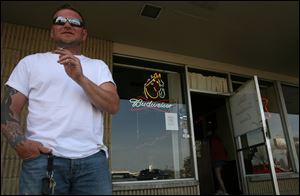
Smoking ban linked to reduction in heart attacks
Health department says business' profits not adversely affected
9/1/2011
A woman holds her cigarette over an ashtray.
THE BLADE
Buy This Image

Jimmy Wolff has a smoke outside of Debi's Southwyck Lounge in this 2008 file photo.
COLUMBUS — Shortly after Ohio enacted its strict, voter-approved ban on smoking in indoor public places, the number of apparent heart attacks dramatically dropped, a state study released Thursday showed.
The Ohio Department of Health also said the law, passed in November, 2006, and enacted in May, 2007, does not appear to have adversely affected the bottom lines of bars and restaurants.
"Symptoms of heart-related disorders, diseases that are clear diagnoses of heart attacks, and public attitudes are all reinforcing that this was a good decision … " said Dr. Ted Wymyslo, state health director. "We were the first state in the Midwest and the first tobacco-growing state to move forward with this type of ban. I want to tell you, it was a wise thing to do."
The studies are the first in a series as the state attempts to gauge the impact of the indoor public smoking ban. Studies examining asthma and birth weight rates are pending.
With few exceptions, the law prohibits smoking in offices, bars, restaurants, clubs, sports arenas, and any other enclosed place that has employees or is frequented by the general public.
Business owners must remove ashtrays and post no-smoking signs or face fines that increase in severity with multiple offenses.
Even as court battles continue over the focus of enforcement on business owners instead of their smoking patrons, the state has begun going after the liquor licenses of bars and restaurants that refuse to pay fines levied for violations.
STUDY FINDINGS
Studies analyzing the effects of the five-year-old indoor smoking ban in Ohio have found that:
There was a 26 percent dip in the number of heart attack-related discharges from hospitals in the months after the state began to enforce the law in May, 2007.
There was no statistically significant change in sales at bars and restaurants that was associated with the smoking ban.
Monthly unadjusted revenue subject to sales tax for Ohio bars was $42 million as of April, 2007, the month before the ban took effect. By April, 2010, that figure had climbed to about $49.6 million.
For restaurants, taxable monthly revenue climbed from $455.9 million to $468 million during the same three-year period.
Although Ohio researchers can't definitively tie it to the indoor smoking ban, they noted that an examination of hospital discharge data showed a 26 percent dip in the number of heart attack-related discharges from hospitals in the months after the state began to enforce the law in May, 2007. The hospital data did not indicate whether the heart attack victims were smokers.
"However, it really is kind of remarkable to see this kind of drop …,'' said David Bruckman of the Cleveland Department of Public Health and Case Western Reserve University, a co-author of the study. "We don't really know why that occurred. We have to assume that it is coincident to the introduction of the first few months of the ban.''
Cresha Auck, director of government relations for the Ohio Heart Association, said a reduction in the number of heart attacks should have been expected as cigarette smoke was removed from places frequented by the public.
"The cardiovascular system is impacted from tobacco smoke exposure within 20 minutes, so that's why you see the heart attack rates come down,'' she said.
The state used sales tax data from businesses that sell alcohol for on-site consumption to examine the economic impact of the ban. Bars, some restaurants, bowling alleys, and other businesses that serve alcohol fought the ban, arguing it would cause many smoking customers to stop visiting the businesses or at least spend less time there.
"There was no statistically significant change in sales that was associated with the Ohio Smoke-Free Workplace Act that has hurt either bars or restaurants,'' said Elizabeth Klein, of Ohio State University's College of Public Health.
"These findings are consistent with studies that have been conducted in cities, counties, states, and countries where there are no significant effects associated with policies that restricted smoking in workplaces."
According to the study, the monthly unadjusted revenue subject to sales tax for Ohio bars was $42 million as of April, 2007, the month before the ban took effect. By April of 2010, that figure had climbed to about $49.6 million.
For restaurants, taxable monthly revenue climbed from $455.9 million to $468 million during the same three-year period.
Maurice Thompson, executive director of the 1851 Center for Constitutional Law and a Rossford native, has a challenge to the ban's enforcement pending in the Ohio Supreme Court on behalf of Zeno's Victorian Village tavern in Columbus. He suggested that health statistics could be interpreted to mean anything.
"We had an expert testify about extensive studies that show no outcome on health consequences, because people don't smoke less," he said. "They just smoke in different places, around the kids instead of in bars. They stay at home and drink more, which leads to unintended health consequences."
He also said the financial impact of the ban discriminates.
"Upscale and trendy bars tend to do well," he said. "It's the local corner bar like Zeno's that loses significant amounts of revenue."
One of Mr. Thompson's clients -- Terry Hymore, owner of the gay bar Rip Cord at 115 North Erie St. in Toledo -- said he's put the bar up for sale because he can't make it financially. A high number of his customers smoke, and they are instead organizing drinking parties in their homes where they can light up.
"Our weekends are nothing here," he said. "We count on weekends to pay the bills. We had three bartenders. We're down to two. We've cut out the cover charges to let anybody in. It has hurt."
"I'm a nonsmoker, but I've been hit so many times with fines that, for about the last six months, I've hired someone to patrol the bar," Mr. Hymore said. "Since then, I've had zero fines. I've just had it."
Much of the time period examined by the state coincided with when Ohio was spending in the neighborhood of $40 million a year in tobacco-settlement funds to help smokers quit and discourage nonsmokers, particularly youths, from taking up the habit. That was all but halted a couple of years ago when Ohio disbanded the anti-smoking foundation and confiscated its funding for other purposes.
Shelly Kaiser, spokesman for the American Lung Association in Ohio, noted that the state saw an uptick in smoking rates in 2010 for the first time since the ban took effect. An estimated 22.5 percent of Ohioans said they smoked last year, up from 20.3 percent the year before.
Ohio this year will spend $1 million on enforcement of the law, using one-time federal funds that won't be available next year.
"The fact that we don't have a lot of readily available funding at this point won't stop us from moving forward," Dr. Wymyslo said. "What we've developed is a tobacco collaborative where we've joined forces with private employers and insurers to see if we can find other ways to fund our tobacco cessation activities.
"Do not believe that our commitment to tobacco cessation has gone down," he said. "It's the number-one best-known risk factor for chronic disease. It causes one in five deaths that happen in Ohio, currently 18,000 a year."
Contact Jim Provance at: jprovance@theblade.com or 614-221-0496.